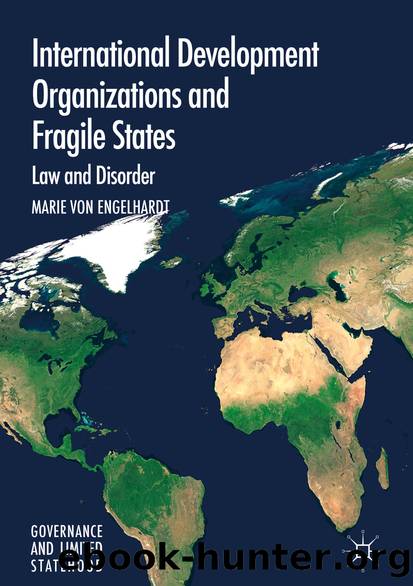International Development Organizations and Fragile States by Marie von Engelhardt

Author:Marie von Engelhardt
Language: eng
Format: epub
Publisher: Springer International Publishing, Cham
3.4 Discussion
Three Operational Policies—OP 10.00 on Investment Project Financing, OP 8.60 on Development Policy Lending, and the Bank Policy on PfoR—regulate how the bulk of World Bank operations are planned, approved, and implemented. The Policies determine under what conditions recipient countries get access to the Bank’s resources, and what roles and responsibilities they assume in the process.149 How has the organization sought to adapt this regulatory framework for operations in weak capacity, high-risk environments?
The World Bank has taken a different approach for each of its three financial instruments. Concerning Investment Project Lending, the Bank has introduced a new section into OP 10.00 that allows for the use of exceptional arrangements when planning and implementing operations in conflict-affected or fragile states. It has thus mainstreamed exceptions that were previously available only under its emergency policy, OP 8.00. Whereas Bank staff had come to rely heavily on OP 8.00 outside of traditional emergencies to engage with fragile states, the revision of OP 10.00 formalizes under what conditions a member state can qualify for exceptional arrangements. They must be requested by the recipient country and approved by the Bank’s Management, on the basis of objective, detailed eligibility criteria, following a process of internal consultations. The revision of OP 10.00 has thus the potential to strengthen the consistency, predictability, and transparency of the Bank’s decision-making.
In contrast to the relatively comprehensive, exceptional regime available for Investment Project Financing in fragile states, OP 8.60 on Development Policy Lending contains only one provision on crisis and post-conflict situations. It enables the Bank to put aside certain requirements in order to use budget assistance on an exceptional basis, if approved by the Executive Directors. Which design considerations can be put aside under what conditions is not regulated in detail, but apparently determined on a case-by-case basis. In principle, this room for discretion can facilitate a flexible and country-specific approach to tailor operations to the specific constraints of fragile states. In practice, however, it is not necessarily predictable and consistent when the World Bank is prepared to provide funding directly to a country’s budget. There seems to be a certain imbalance within the group of fragile states that is difficult to explain on the basis of technical considerations alone, and suggests that the decision to use budget assistance could be politically influenced.150 At the same time, the decision to channel resources directly to a country’s budget has significant consequences for the countries concerned, as it is usually seen as a signal of political endorsement.
The Bank Policy on PfoR, in turn, does not contain any special provisions for fragile and conflict-affected. The Policy does, however, establish a legal framework for Bank operations that is flexible and adaptable to different circumstances in recipient countries, including fragile states. Due to the novelty of the instrument and the scarcity of implementation experience,151 it is too early to assess the suitability of PfoR financing for conflict-affected and fragile states in practice.152
Judged on the basis of the three Policies, the World Bank’s approach reveals some patterns, but remains little systematic overall.
Download
This site does not store any files on its server. We only index and link to content provided by other sites. Please contact the content providers to delete copyright contents if any and email us, we'll remove relevant links or contents immediately.
| Arms Control | Diplomacy |
| Security | Trades & Tariffs |
| Treaties | African |
| Asian | Australian & Oceanian |
| Canadian | Caribbean & Latin American |
| European | Middle Eastern |
| Russian & Former Soviet Union |
The Secret History by Donna Tartt(16621)
The Social Justice Warrior Handbook by Lisa De Pasquale(11489)
Thirteen Reasons Why by Jay Asher(7788)
This Is How You Lose Her by Junot Diaz(5768)
Weapons of Math Destruction by Cathy O'Neil(5036)
Zero to One by Peter Thiel(4824)
The Myth of the Strong Leader by Archie Brown(4789)
Promise Me, Dad by Joe Biden(4446)
Beartown by Fredrik Backman(4415)
Stone's Rules by Roger Stone(4415)
How Democracies Die by Steven Levitsky & Daniel Ziblatt(4398)
The Fire Next Time by James Baldwin(4342)
100 Deadly Skills by Clint Emerson(4076)
A Higher Loyalty: Truth, Lies, and Leadership by James Comey(4032)
Rise and Kill First by Ronen Bergman(4012)
The David Icke Guide to the Global Conspiracy (and how to end it) by David Icke(3881)
The Farm by Tom Rob Smith(3872)
Secrecy World by Jake Bernstein(3782)
The Doomsday Machine by Daniel Ellsberg(3730)
